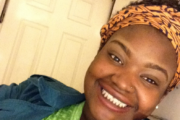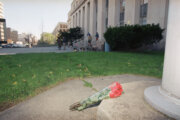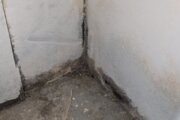Jordan wakes at 6 a.m. She helps her mother, who is recovering from surgery for breast cancer, into the bath. Jordan has it all timed. She gulps down breakfast as her mother bathes, and returns to help her out of the tub. “I’ll make sure her bandages are clean and didn’t get too wet,” Jordan says. “And if they did get too wet, I change them.”
Her mother is disabled from painful fibromyalgia, so Jordan takes her to her room, where her mother can dress herself. That gives Jordan a chance to get ready for school and walk the dog before her mother, slowly moving into the car, drives her to school.
In the evening, Jordan, who asked to be identified by first name only, tends to the family’s animals. She helps her mother into bed and wraps a thermal blanket around her. Finally, she has a chance to eat dinner, do homework and wind down before going to sleep. Bedtime can be past midnight for the Florida ninth-grader. It’s a long day for a 14-year-old.
About 1.4 million children between ages 8 and 18 are caregivers nationwide, according to the American Association of Caregiving Youth. Evenly divided between girls and boys, about a third are between 8 and 11, and nearly 40 percent are between 12 and 15. Most often, the family member is a parent or grandparent, with a condition such as Alzheimer’s disease or dementia; heart, lung or kidney disease; arthritis or diabetes.
Kids take on a wide range of responsibilities. Most common are chores like shopping, fixing meals and household tasks, or keeping the family member company. Hands-on care includes helping loved ones with day-to-day activities such as bathing, dressing and toileting; getting in and out of bed and chairs; and feeding.
Navigators and Earners
Teen caregivers frequently help parents figure out medications, follow up with doctors’ appointments and speak up when there’s a problem, says Carola Bracco, CEO of Neighbors Link Network in Mount Kisco, New York. In immigrant families from countries with limited access to health care, routines such as seeing specialists and double-checking prescriptions may seem like “almost a luxury,” especially for a family living in poverty, Bracco says.
A U.S.-born teen may have a higher level of education than was available to a parent, so a high-school student could be better equipped to handle health care communication and navigation, she says. In households without cars, teens often accompany extremely ill parents who must take public transportation to doctor’s appointments.
“The incredible loyalty [teens] feel toward the whole family adds a significant amount of stress,” Bracco says. “In the jobs that many of these parents have, they’re not getting paid when they’re not working. So then teenagers are out finding work, and having to work 30 or 40 hours a week, while still trying to be in school.”
School, Social Life and Stress
In addition to her mother, Jordan also helps care for her grandmother and uncle, who both live nearby with Type 2 diabetes. Caregiving can conflict with schoolwork. “You have to have a certain level of maturity to do it,” she says. “At first, it did impact my grades a little bit. But over time I got used to it, and now my grades are much more stable.” A determined student, Jordan is already planning a career in medicine.
Still, it’s not always easy to concentrate in class. “When you care give — especially for parents and relatives and people you have a special relationship with — you become extremely stressed,” she says. “You worry about them because they become like a baby to you. They depend on you to help them.”
Meeting and spending time with friends is problematic. “When my mother is feeling good, she will take me to some places,” Jordan says. “I tend to have fun at school, because I’m a nerd. So yes, I do have fun.”
Siblings Step Up
Sometimes caregiving is about brothers and sisters. Jason Lopez, coordinator for the North American Family Institute wraparound program in Westchester County, New York, recalls a case of a 16-year-old boy removed from his birth mother’s care due to allegations of neglect. His 18-year-old brother volunteered to act as the temporary caregiver.
The older brother has a mental-health condition, Lopez says, and the younger brother has delayed mental development and chronic health issues. But the older brother was high-functioning enough to handle the situation, Lopez says, and it was urgent.
“He was the only identified person that stepped up to care for his brother,” Lopez says. “If not, the brother would have gone directly into foster care.” The program supported the older brother in his efforts, and eventually the staff connected the younger brother to a long-term program for people with developmental disabilities.
The NAFI program also worked with a 19-year-old girl caring for three younger siblings who had been removed from their mother’s care. “The older sister had moved out and was living her own life,” Lopez says. When the younger kids reached out to her, she took them in. The teen enrolled in the county’s kinship foster program, and the family receives a variety of services — financial, mental health, medical transport and overall support. “She’s doing very well,” Lopez says.
Filling a Vacuum
“We, as adults, are supposed to be taking care of children,” says Connie Siskowski, a former youth caregiver and president and founder of the American Association of Caregiving Youth. “They’re not supposed to be taking care of us. What goes on behind closed doors nobody really knows.”
At 10 years old, Siskowski became her grandfather’s caregiver. “My grandfather and I were just really, really close,” she says, and he was her hero. Siskowski took on the caregiving role by default. “Nobody else was involved to the extent I was,” she says. “Also, I loved him so much. It was just like a natural thing to do.”
But it was troubling, too. Giving personal care to her grandfather was uncomfortable. And finally: “I went in to give him his medicine at 2 o’clock in the morning,” she recalls. “When I did, I found him dead. That was traumatic.”
Her childhood experience and awareness of the negative impact that child caregiving can have on school success motivated Siskowski to start AACY. The nonprofit supports caregiving kids in myriad ways, including academic resources, financial assistance, caregiving education and camps to connect young caregivers to peers.
Serious Caregiving
Emotionally, when caregiving kids take on adult roles, they may experience “parentification” and become “medicalized,” according to the American Psychological Association.
Physically, kids can injure themselves while trying to turn or lift disabled adults. “Before my mother had cancer, she was a lot heavier,” Jordan says. “Even though I had training, I’m a 14-year-old girl. I’m not that strong. So it does go hard on the muscles of the upper body.”
Kids who aren’t trained in infection precaution may put themselves at risk when providing certain caregiving tasks, for instance in cases of HIV/AIDS.
Age-Appropriate
Ideally, kids will handle tasks that are suitable for their age — not in isolation, but as part of a caregiving team, says psychologist Rosalind Kalb, vice president for health care information and resources at the National Multiple Sclerosis Society, which serves families affected by MS.
“My guideline is that kids shouldn’t be asked to do things that make them uncomfortable or that make them anxious,” Kalb says. The larger issue, she adds, “is whether we’re asking kids for something that is just too big for them or too stressful, because they need to be able to be children.”
Caregivers of any age can go to the National MS Society’s website to seek counseling, respite care assistance, financial assistance for short-term needs and getaway camps, plus coordination with community social service facilities. Many disease-focused groups like the Lungevity Foundation offer caregiver help and resources through their websites and outreach.
Not Alone
There’s light at the end of the tunnel for Jordan. “Seeing the people I’m taking care of feel better gives me a sense of hope that things will get better,” she says. She’s confident AACY will continue to help her mother when it’s time for college, particularly if she goes out of state.
Through AACY’s Caregiving Youth Project, Jordan learned she’s not alone. “I felt much more relieved and less embarrassed because I wasn’t the only one,” she says. “I met one of my best friends, and I’m still friends with her today. We can relate. All the kids can relate.”
More from U.S. News
How to Be a Good Patient Wingman
Do’s and Don’ts of Home Medical Devices
14 Ways Caregivers Can Care for Themselves
When Kids Are the Caregivers originally appeared on usnews.com






